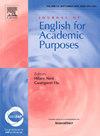“这样的比较未能……”:社会科学研究论文文献综述部分被忽视的开放式否定
IF 3.4
1区 文学
Q1 EDUCATION & EDUCATIONAL RESEARCH
引用次数: 0
摘要
尽管越来越多的人关注学术写作中的否定,但研究主要集中在封闭课堂的否定(例如,not, no, never)。然而,否定也可以通过一系列开放式的形式表现出来(例如,fail, lack,不足),这些形式在自然语言研究中得到承认,但在学术话语分析中往往被忽视。本研究通过对6个社会科学学科的180篇英语研究论文的文献综述部分,对比开放式否定和封闭式否定的使用频率和交际功能。考虑到识别开放式否定的实际复杂性,该研究通过结合大型语言模型和人工检查来检索和分析否定实例。结果发现,开放式否定比封闭式否定的发生率高。与封闭否定相比,开放式否定在信息和情感交际功能上的使用频率更高,并为调整命题的力量提供了更多的选择。这些结果表明,迄今为止被忽视的开放式否定是学术写作中至关重要的语言资源,它为作者在选择否定表达和以调节力量建立立场方面提供了很大的灵活性。本文章由计算机程序翻译,如有差异,请以英文原文为准。
“Such comparison fails to …”: The neglected open-ended negatives in the literature review section of social science research articles
Despite increased focus on negation in academic writing, studies mainly center on closed-class negatives (e.g., not, no, never). Nevertheless, negation can also be manifested through an open-ended array of forms (e.g., fail, lack, insufficient), which are acknowledged in natural language research yet often overlooked in academic discourse analysis. This study examines the frequency and communicative functions of open-ended negatives in contrast to closed negatives within the literature review section of 180 English research articles across six social science disciplines. Given the practical complexity of identifying open-ended negatives, the study retrieved and analyzed negation instances through a combination of a large language model and manual inspection. It was found that open-ended negatives display a higher occurrence than closed negatives. In comparison to closed negatives, open-ended negatives are utilized more frequently in performing both informational and affective communicative functions and provide more alternatives for adjusting the force of propositions. These results suggest that the hitherto neglected open-ended negatives are crucial linguistic resources in academic writing, affording writers great flexibility in selecting expressions of negation and establishing positions with modulated force.
求助全文
通过发布文献求助,成功后即可免费获取论文全文。
去求助
来源期刊

Journal of English for Academic Purposes
Multiple-
CiteScore
6.60
自引率
13.30%
发文量
81
审稿时长
57 days
期刊介绍:
The Journal of English for Academic Purposes provides a forum for the dissemination of information and views which enables practitioners of and researchers in EAP to keep current with developments in their field and to contribute to its continued updating. JEAP publishes articles, book reviews, conference reports, and academic exchanges in the linguistic, sociolinguistic and psycholinguistic description of English as it occurs in the contexts of academic study and scholarly exchange itself.
 求助内容:
求助内容: 应助结果提醒方式:
应助结果提醒方式:


